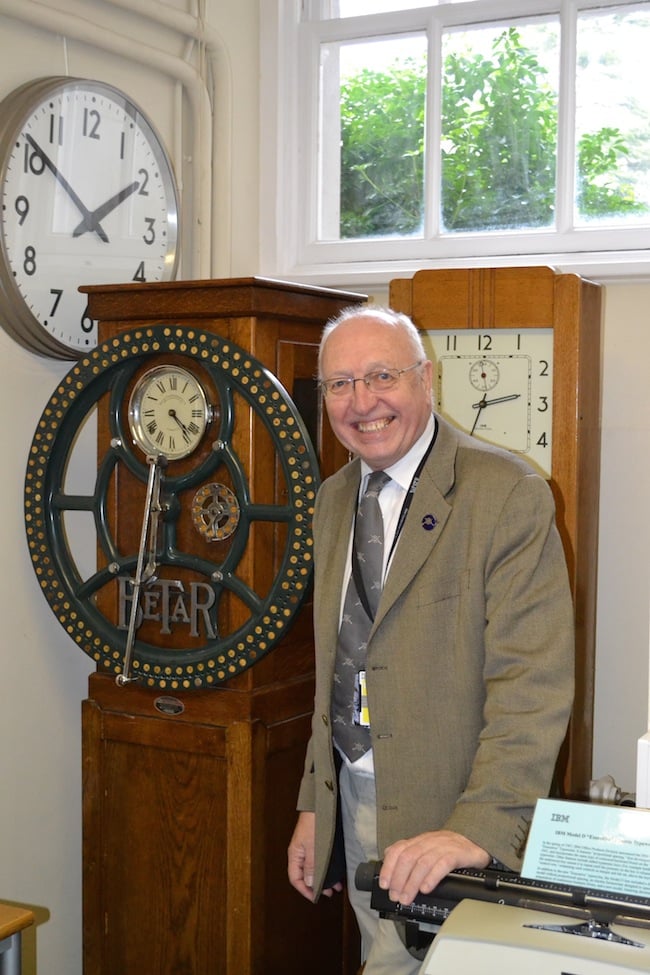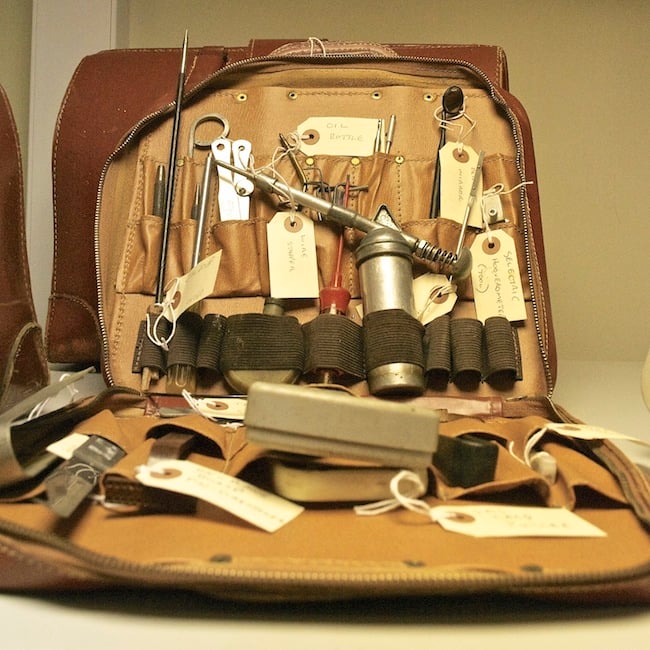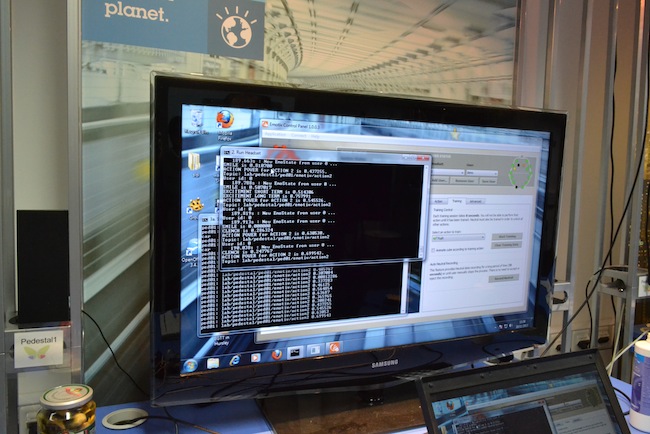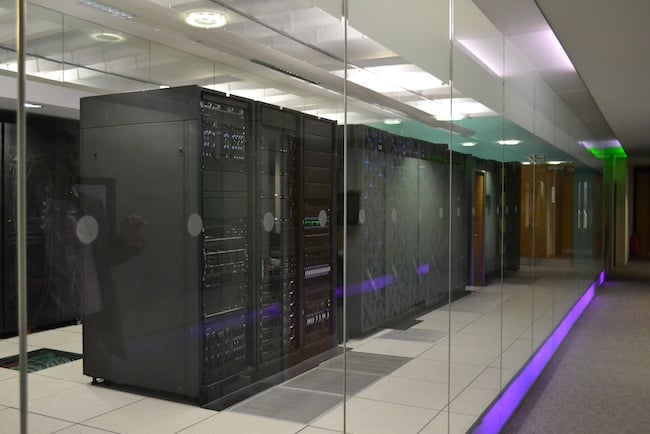Original URL: https://www.theregister.com/2014/04/10/geeks_guide_visits_ibm_hursley/
IBM Hursley Park: Where Big Blue buries the past, polishes family jewels
How the internet of things has deep roots in the English countryside
Posted in Geek's Guide, 10th April 2014 09:00 GMT
Geek's Guide to Britain Would you like to work in a cross between Downton Abbey and Silicon Valley? For a small selection of IBMers, that’s the only way to describe their working environment, although the place we’re talking about is officially called Hursley Park.
You can get there by turning off the M3 and rattling through some pretty English village-hood before hitting Hursley, a high-end hamlet straddling the A3090. Cross over, skirting the stone bench built around a tree trunk, and you’ve entered the gateway to the Hursley Park estate, home to an IBM R&D lab since the late '50s.
It was cold and grey the day we went. Chain link fences on either side of the road make it feel like you’re entering some kind of government research facility. Think Baskerville in the BBC’s 21st century take Sherlock. However, this slightly forbidding entry quickly gives way to wide open green parkland with wooden paddock fencing.
A pheasant perched on a fence post looked completely unconcerned as we set course for the main house. While there are signs aplenty for the IBM tennis and cricket clubs, presumably there’s no shooting club.
The estate itself has a chequered history, at one time belonging to Oliver Cromwell’s son Richard; then the Heathcote family, who built the guts of the current house; the Baxendale family - owners of Pickfords; and then the Coopers, who massively extended the Heathcote’s house.
So far so Brideshead. But things took a high-tech turn in the 1940s, when the house was requisitioned by the government and became a country hideout for Vickers Supermarine's design team, where they carried out refinements of the Spitfire and Hurricane, and laid the groundwork for the UK’s post-war jets.
After the... let’s say... consolidation of the British aerospace industry, an up-and-coming US technology firm called IBM moved into the building in the 1950s, initially using the house as a development lab, before buying the estate in full in the 1960s.
Big Blue brownfield
The site has been instrumental in the development of IBM’s software technologies since the 1950s, as well as displays and disk-based storage, though those lines have now departed. It is still the home of development for CICS MQ Series technology. Or, put another way, the software that probably runs transactions on the mainframe underpinning your retail bank, and ensures the oil finds its way along the pipeline to your local petrol station.
Pulling up outside the house itself feels like the beginning of an intimate weekend in a country house hotel. Open fields to the left, woods to the front, imposing Queen Anne portico to the left. Where are all the engineers, we wonder, before musing on whether we can expect an imposing yet slightly eccentric butler to announce our arrival.
We then realise we’re at the wrong entrance. A walk around the side, past the old house’s orangery/conservatory, brought us to the thoroughly modern plate-glass reception area, which fronts the vast complex of development labs.
We were picked up by our minder for the day, John from IBM’s press operation, rather than a trusted family retainer, and taken into the main complex.
The wall immediately behind the lobby was lined with portraits. These were not of Hursley's previous inhabitants, but of the current inmates, complete with job titles like senior inventor.
Our first move was to walk back to the grand house, via a covered walkway which connected via the conservatory. En route, we passed a massive model of the site, which revealed just how much office and lab space had been plonked down in this quiet corner of Hampshire. How had IBM managed to get this all past the planners and into the middle of Jane Austen land? Mainly by building over the footprint of the massive hangars and drawing rooms that had been there previously, courtesy of Vickers - brownfield development, before the term was actually invented.
Into the main house and up to check in with John Mclean, IBM VP and lab director (Mclean has since become IBM VP and CTO for Europe). And then it was time to descend into the bowels of the house – to visit the museum... in an R&D centre.
But surely it was just a collection of knick-knacks to amuse passing visitors? Shouldn’t it be in reception?
IBM's skeletons in the basement
Hardly. A visit to the basement of Hursley opens up an Aladdin’s cave of kit that you’ve either heard of spoken in whispers, or, if you’re old enough, will spark memories of long days spent hacking code, or perhaps just hacking recalcitrant IBM kit to bits.
Our host for our visit was curator Terry Muldoon. The ebullient IBM veteran is an enthusiastic pitchman for generations of Big Blue’s kit, all the more so given that everything he shows us has been off the catalogue for years.
The museum’s story begins well before the birth of IBM as we know it. Muldoon shows off the original Hollerith product range - weighers, punch clocks and the like. This was IBM’s bread and butter before it became the Computing Tabulating Recording Company - the firm’s name before it rebranded again as International Business Machines in 1924.
Time flies, and before you know it you’re looking at punch card machines, and remembering those two summers you spent working at a market research firm in the 1980s, where results were still processed on an armful of heavyweight paper. We see early circuit boards which look more like the innards of 1940s radiograms rather than a PC motherboard, complete with bulbous glass valves. There are plenty of typewriters, of course, to spark any deep-seated Mad Men-type fantasies.

Terry Muldoon: Still clocking on
A side room holds a collection of RS/6000 machines. Muldoon explains that much of the kit was collected after the fact - ex-marketing kit, for example - and that only recently has the firm actually thought to keep an archive of its wares. Why warehouse technology when you can sell it? In another room, Muldoon shows off what must be one of the last token ring networks running in the UK.
There is plenty of heavyweight veteran storage. Storage was one of the site’s areas of expertise, and Hursley delivered many storage firsts. However, the estate was not the birthplace of the Winchester drive. While the Ancient English capital is just up the road, the Winchester was so named because it had two storage modules of 30MB each, recalling the 3030 Winchester rifle cartridge. All the same, Muldoon has both the storage and the ammo versions on display.
Where the museum really springs into life – for us at least – is with the onset of the mainframe. One room is kitted out as a service room for a mainframe circa the '60s. From the manuals detailing the software and innards of those early monsters, to a range of tools that would put even the most gadget crazy mechanic or surgeon to shame, it shows just what level of resource the early computing customers were prepared to shell out for to keep their machines – and companies – running.
We particularly liked the fact that the mainframe engineers were provided with a portable toolkit which fitted into a portmanteau, which would have make the bearer look less like a mobile service engineer and more like some sort of crazed gynaecologist.
The only thing missing is a waxwork of an engineer in a blue suit, white shirt and tie diligently working through his fix list procedure, ideally with another waxwork of a a sweaty and increasingly agitated client clutching the door frame. And of course the soundtrack of one of those mighty beasts and its whirring tapes and clunking buttons.

OK mainframe, this is going to sting...
We've hit the motherlode: Beige boxen from the '90s
Through another room, and we hit the PC era, with racks of beige boxes along one side, from the first IBM PC through PS/2 and beyond. The range extends at least as far as 2005, when the x86 client business was offloaded to Lenovo. Facing off against them are the vendor’s erstwhile notebook offering, Thinkpads, including keyboard-free touchscreen devices dating back as far as 1993. Like that was ever going to catch on.
The racks of now-obsolete personal computing kit in particular poses hosts of questions. These devices had a fraction of today’s power, but this writer at least remembers how cutting edge and revolutionary they were when they were released – feel the might of the 486 – giving buyers that sliver of competitive edge that justified the thousands of pounds they cost back in the '80s and '90s. How quickly obsolescence comes around.
Food for thought for the site’s latest crop of cutting edge developers surely? Apparently not. Asked if Hursley’s inmates like to take a trip downstairs to gaze at the racks of ATs or ThinkPads or green screen terminals for inspiration, McClean is blunt. “No, I wouldn’t say they do.”
“They’re historical things, right?” he continues. “They’re not going to shed new light on the world or anything else. You can reflect on things – that people made decisions at different points in time. It’s more that you can see those opportunities at different times then.”
It’s a fine balance. Focus remorselessly on the future, and be in danger of forgetting the mistakes of the past? Or continuously fight yesterday’s war, even as others create a new future around you. It’s a dilemma for any technology company. You might have your own view on Big Blue’s history, but it will probably ask you to name any other IT companies that have been around for over 100 years.
Big Blue probes Reg journo's brain
As we emerge from the bowels of the oldest part of the house, glimpsing into rooms bursting with un-catalogued or unrestored IBM kit, Muldoon mentions the strong rooms maintained by the various families who owned Hursley. One remains unopened apparently.
From there, it’s back into the 21st century, or as IBM calls it, the Emerging Technology Services Lab. This is where those people with titles like "senior inventor" live, or at least demonstrate their most interesting projects. The day we arrived, demos were heavily focused on the internet of things, including a walk-through on a system for integrating building plans, service requests, sensors, and manuals. This included augmented reality overlays of manuals and repair procedures. The kind of thing you see demonstrated for M in the latest Bond movies? Chances are the plumber at MI6 will be using it first.
Remote healthcare was another hot topic. When the City of Bolzano in Italy decided to pitch itself as a retirement destination, it called in IBMers from Hursley to examine ways of monitoring the oldies without having to provide each with a personal butler. The result is a huge degree of instrumentation, monitoring health as well as more tangible issues, such as utility use, carbon monoxide and the like. The aim is to both maintain a more holistic picture of the residents' health and ensure scarce human resources are targeted more accurately.
Node-RED, another Hursley-developed technology, is a visual development environment to connect devices such as sensors, and link them into other systems – a tool to help "wire" the internet of things. It is based on the MQ technology which underpins more traditional machine-to-machine communications, and which was developed at Hursley.
If you want to get truly bleeding edge, consider the use of brainwaves as computer interface. It was in service of this concept that your reporter found himself with a headset strapped to his bonce and told to empty his mind and then control a remote control car. Years of covering technology meant your reporter emptied his mind so well he forgot to film his subsequent mental driving escapades – although he did manage to get a snap of the onscreen code that represented his virtual brain dump.

Your writer's brain mid-dump
So, Hursley shows us the future of IBM, and technology, as well as the past.
What about the present, which is of course where the bread comes from in the inverted sandwich that is the real world.
You’ll be happy to know that there are real developers working on real present day technology. As we said, Hursley is home to CICS and MQ development as well as a chunky amount of IBM’s Java development. But again, this is an R&D lab, where the real world does overlap with the future. Thus Gerry Reilly, Development Director and CTO, IBM Messaging was happy to wax lyrical about the technology’s leap from its roots buried in pipelines and other difficult-to-reach applications and into our cars and fridges.
MQ’s domain has traditionally been SCADA-type systems, oil pipelines and the like - seriously important, but off the radar of technology’s cool kids and gadget heads, except for the more extreme security nuts. Reilly chuckles as he contemplates how the last few years have seen the same sort of architectures supporting networks of sensors, often from “hobbyists”.
Now, he says, IBM is currently working with serious players in the automotive and white goods sectors, while the principles are being applied in areas such as modelling weather. “A lot of it is being driven by business partners.”
Sadly, he wasn’t able to tell us from which fridge we should be buying if we want to ensure our eating habits are borged into big data analytics systems. IBM has poured cash into acquiring analytics firms over the last six years. It’s almost as if it had taken a long-term view of where technology was going to be heading in the twentyteens and taken a big bet on it.
While Reilly acknowledges that the instrumentation of so much of our every-day life throws up a myriad of cultural, privacy and legal implications, this is for society and business partners to thrash out: “IBM is not going to take a position.” But it will develop and sell you the technology to take your own.
If that gives us plenty to think about as we criss-cross the site, we can distract ourselves by by ruminating on the development of business architecture over the last 40 years. One minute you feel like you’re in a 1970s newly built poly, the next that you’re on the set of The Office. The site really seems to straddle multiple eras – just as the original house does.
Noses against the glass
Our last stop of the day brought things right up to date, as we hit Client Centre, overseen by Mike Sexton. This is what you’re most likely to see if you’re part of the IBM ecosystem – ie, a reseller, developer or customer. Or at least a potential part.
Whereas the museum covers the IBM customer as it was, the partner centre shows today’s customer what their technology could be. The focus isn’t really on legacy, but rather on the sleekest top-end IBM kit, including its latest mainframes, as well as its POWER Systems.
It’s like looking into Harvey Nicks window for techies: everything is sleek, black, well-lit and behind glass. It’s how the data centre of your dreams looks - no boxes of tapes or bags of cables lying around on the floor, no jars of ear-plugs attached to the wall.
However, the aim is to allow customers, partners and developers to experiment and see how IBM software or kit might fit their requirements. If those requirements mean some legacy kit to slow things down - well someone could always haul out a token ring network from the museum if you really wanted.

Does anyone's data centre actually look like this?
If that’s all a bit bare metal for your liking, the centre has a series of “industry labs” showing just how IBM technology can feed into real world apps.
So you can also fantasise about being a global baddie, or attempting to defeat the same, in the centre’s own “situation room”, complete with banks of consoles, big screens and conference table. IBM has built a much larger situation room for the municipal government of Rio de Janeiro, so the proof of the pudding will be in the eating during the World Cup and Olympics. Another room focuses on crime, highlighting the predictive technology IBM claims has helped actual cops catch actual bad guys in the act.
IBM’s vision of the modern home includes an array of smart meters bursting out of a dresser beneath a flock of geese. Opening one of the cupboards below unleashes a flock of smart meters. It’s somewhere between Coronation Street and Brookside, rather than Downton. There’s no hint of a robot butler to tactfully suggest one might want to turn down the heating; rather IBM envisions smart meters combining with utility firm’s analytics systems to keep you updated via the TV.
Still waiting for the robo butler
If you’ve shaved a few pennies off your fuel bill, you might want to go shopping. And there is of course a retail lab, showing how IBM tech can underpin the entire retail experience, from campaign management, promotions and e-commerce to point of sale. One of the technologies underpinning the demo is called Tealeaf. It analyses why transactions aren’t completed - though of course to this London-based writer, it sounds like a security application at best.
It’s slightly eerie, sitting there towards the end of a winter’s day, looking at “the future”, with shelves full of fake salad and cheese, and sealed but empty wine bottles and cereal packets. You feel that if you opened one of the cereal boxes you’d find blue goo.
But there’s another eerie aspect to this ersatz retail experience. Time was when you walked into a shop, it was a fair bet the scanner had an IBM logo on it. Not now. IBM moved out of that business a long time, just as it has moved on from laptops, notebooks and printers, not to mention the display and disk-based storage technologies where Hursley in particular forged ahead.
So, as McLean says, “You have to be willing to change and accept that the market changes and the world changes. Against that backdrop you’ve got to innovate.”
He continues with the happy brutalism of the engineer: “You...have to walk away from things that you potentially invented... When we stepped away from punch cards, we were making a huge amount of money from that business but you know when you look to the future, you have to accept that occasionally you have to walk away from businesses.”
And perhaps that that’s one of the true wonders of Hursley: a place where the future is designed even as 20-year-old technology is prepared for display in the museum, while just a few feet away, 50-year-old technology is tweaked to ensure today’s mobile and cloud-based tech keeps on ticking over.
It’s arguably a much more realistic alternative to the all-or-nothing year zero approach of many tech startups. Though we still miss the butler. ®
IBM Hursley Park
GPS
51.0268375,-1.3986139
Postcode
SO21 2JN
How to get there
IBM’s directions are here
Entry
You’re probably not getting into the whole site unless you’re part of the IBM “ecosystem”. While the museum is not open to the general public, group visits can be arranged.